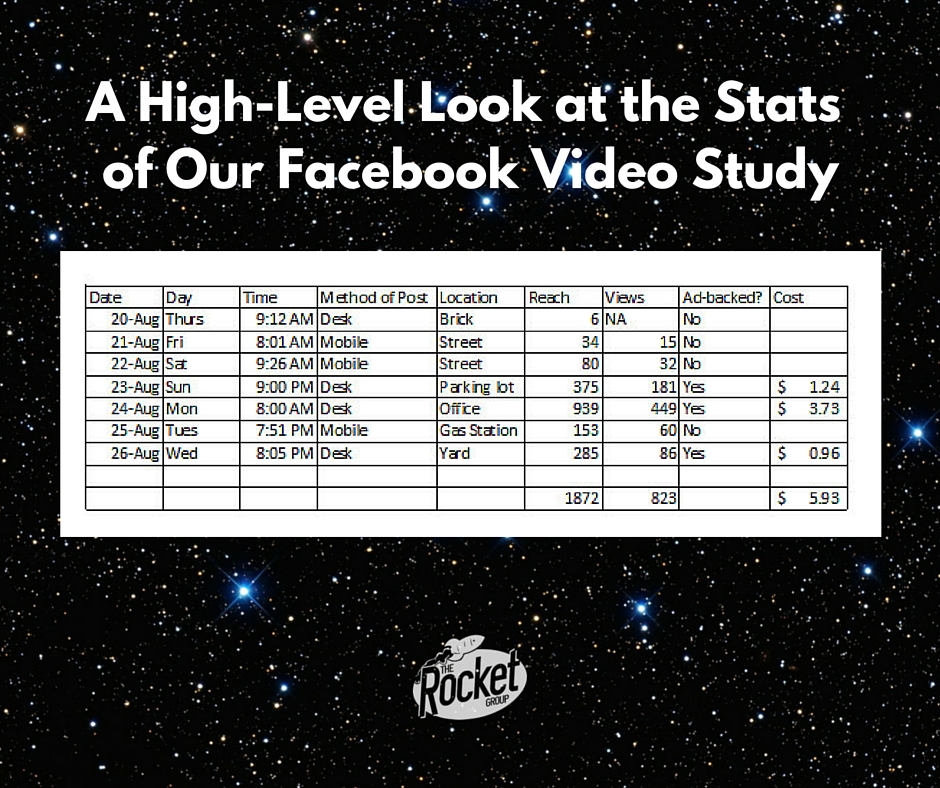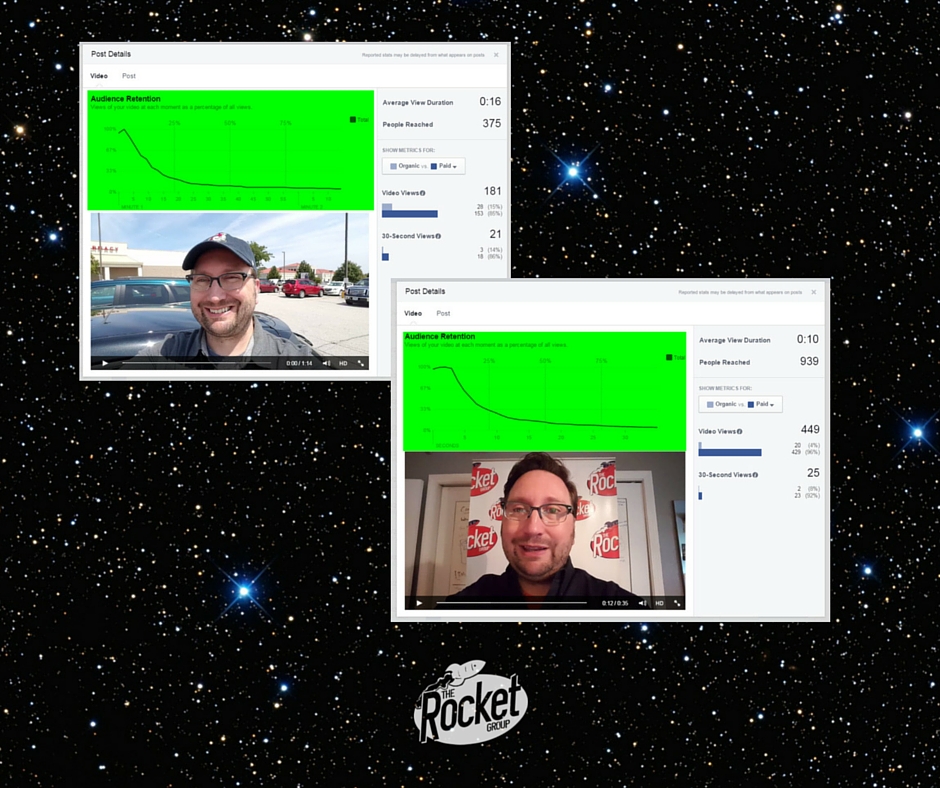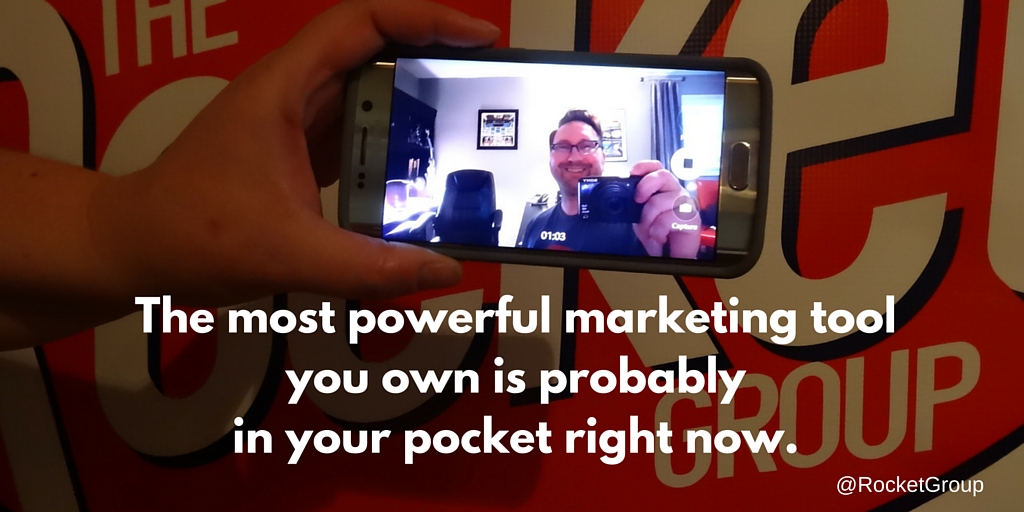Methods We Used for Facebook Video
Admittedly, the “Question of the Day” format we used in this test was inspired by Gary Vaynerchuk, and his decision to dump his Question of the Day. It was a good choice to create some interest in what was being said behind the auto-play functionality of Facebook.
All of the videos were filmed on my Galaxy S6 Edge instead of our higher dollar camera equipment. This was done to reinforce our encouragement that anyone can create video content. Also, we were testing results of posting from the mobile device against posting from the desktop.
Also, true to my “one-take-Jake” tradition, we didn’t edit any of these videos. I also aimed to keep them at a minute or less (only broke that barrier once!), not repeat filming locations, and bring value through the questions and the backstories. We also tested organic reach versus paid reach and found some interesting information.
Technical Results of the Facebook Video Study
In a high-level view, the results look outstanding. 44{1ccf3f7051f621f207bf0b5abe66fecd9fcbebd6ccca57cd81eaf6422f6a0a70} of people who saw our videos in their

The two items here that jump out are the escalating reach, even in the non-paid posts, and the fact that the paid posts only cost $5.93 for hundreds of views.
As you may know, Facebook counts a view as when one individual has viewed more than 3 seconds of the video. When we look at the viewing time of each of the seven videos in the study, we see that the average viewing time was 12.85 seconds or 29{1ccf3f7051f621f207bf0b5abe66fecd9fcbebd6ccca57cd81eaf6422f6a0a70} of the average video.
Deep Look Results of the Facebook Video Study
In your Facebook Insights, you can click each individual post and see a ton of information on fan interaction, or inaction. By looking at each of these posts, we learned that while the organic reach was great and the views were more than expected, our most desired fan action – link clicks – wasn’t that great. Several of the posts didn’t include links at all and those that did were to evergreen content here on the TRG site.
(Aside – While the clicks weren’t that great we did pick up new fans, and most importantly, a new prospect to do business with.)
We also see, as is the norm for videos like these, that very few viewers made it all the way to the end of their viewing. A 29{1ccf3f7051f621f207bf0b5abe66fecd9fcbebd6ccca57cd81eaf6422f6a0a70} view length isn’t great and tells us that these types of raw one-take videos shouldn’t be a featured form of content, but a complimentary form of content.

Conclusions of the Facebook Video Study
First, posting seven videos in seven days is not nearly enough of a sample to arrive at scientific confirmations. To use a popular term in baseball, it’s a small sample size. Knowing our fan base the way we do and Facebook the way we do, it’s a good start and enough to have some takeaways to share with you:
- Get your point across in the first few seconds of the video. If the viewers are going to fall off after the first third of your content, then you have to hook them early. This is something we practice in our full-on edited videos and is a mental cue we will have to remember in these mobile phone videos.
- The organic reach, at this moment of typing and posting, blows every other type of Facebook post out of the water. We’ll always advise caution to keep a mix of content – optimized photos, videos, graphics, text, etc. – posting from your page but you should really be trying organic uploads of video if you aren’t already.
- Facebook ads for video views are, again at this moment of typing and posting, extremely affordable. See the spreadsheet above and realize we spent less than $6.00 for more than 700 highly targeted views. Good luck doing that with your newspaper ads.
- When filming a video with your mobile device, you have the power to shake up the backgrounds, looks, even the subjects in the videos. That video camera in your pocket right now is probably the most powerful video camera you own. Put it to work for your business, organization, or nonprofit and get great social media content too!
- While you should be creating a video to post to Facebook, you shouldn’t forget YouTube. That being said, the people who see your Facebook videos are people who have already connected with you. For most of us, the people who find us on YouTube are ones that are searching and finding you or that you have blasted links out to through other social media channels. It’s the old reactive versus proactive model all over again.
- The world, at least its online audiences, are quickly moving to a video-consumption-first world. That’s why Facebook is battling YouTube as hard as they are right now. You’ve got to be prepared. You already have the tools. Now you just need to take the time to put them to work for you.

The Facebook videos in the QotD experiment are embedded below if you are interested. If there is anything we can do to answer your questions, help you overcome a marketing
Thanks for the time, for watching the videos, and for checking our math above!



